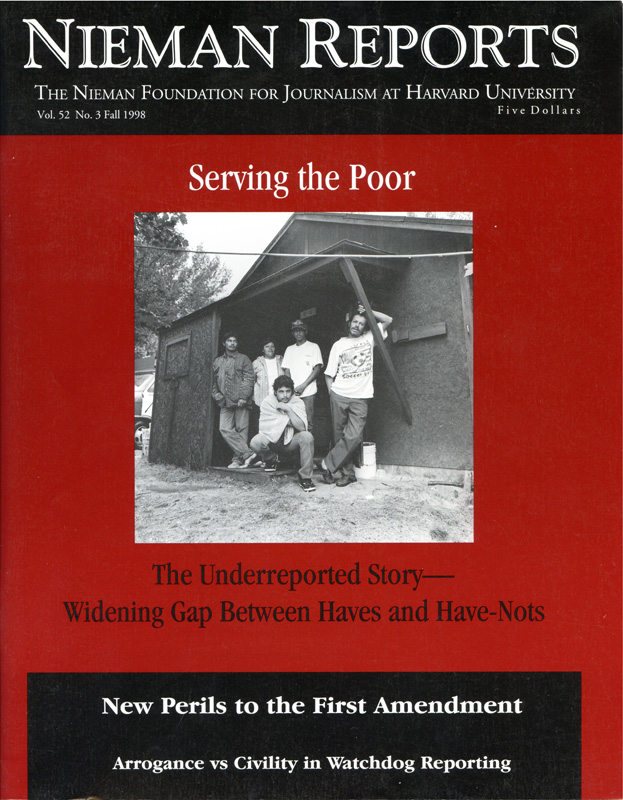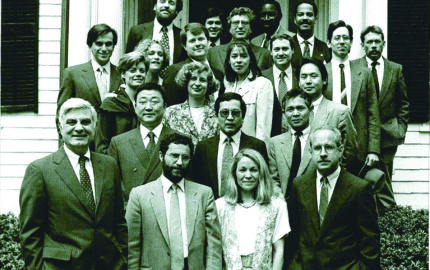As this issue of Nieman Reports goes to press, Sirius, the Dog Star, rises with the sun. We are in the midst of dog days, and the suspicions of the ancients that it is a time liable to madness are hard to ignore.
Consider this record of the American press under the influence of the Dog Star these last three years:
- July-August 1995 saw a massive reorganization of media companies with the merger of Walt Disney-Capital Cities/ ABC, a merger which, along with that of Time and Warner Brothers, placed the masters of fantasy in charge of major news organizations.
- In July-August 1996 three journalists of national stature—Newsweek Editor Maynard Parker, Newsweek political columnist Joe Klein and Random House Publisher Harold Evans, entered into a conspiracy to lie about Klein’s authorship of the book “Primary Colors” to protect the promotional campaign to make the book a bestseller.
- July-August 1997 were the days of the paparazzi pursuing Princess Diana’s death car through Paris and raising again questions of the excess of a celebrity-drunk press.
- And now, falling like the blows of a trip hammer, we see CNN and Time Magazine stand accused both of libel and of cowardice at this summer’s end—libel by the Pentagon for airing and then retracting the most explosive charges since the My Lai massacre, and of cowardice by the two producers fired by CNN; we see Stephen Glass at The New Republic and Patricia Smith at The Boston Globe exposed as liars and a weeks-long drama in which Mike Barnicle forced The Globe to withdraw a demand for his resignation over a column many thought had been plagiarized and then, a few days later, resigned after being confronted with a 1995 column written without checking the facts.
One veteran journalist in Washington was saying he feels as if he’s cleaning out the urinals of journalism as he reports on this scandalous behavior. More humiliating to American journalists who have inspired, prodded and goaded international colleagues with lofty rhetoric of the First Amendment were the words of Gustavo Gorriti (Nieman Fellow 1986) published in late July in The New York Times. Gorriti, Associate Director of La Prensa in Panama, wrote, “From afar, the recent spate of journalistic embarrassments in the United States suggests that something more disheartening is at work than an epidemic of editors falling asleep at the wheel.”
It would be comforting to be able to point to the calendar of the record and blame it all on our stars. But something more fundamental in ourselves is at work and even the most complacent journalists today are beginning to ask: Can you believe the press anymore? Or has the market economy and the lust for self-aggrandizement completely eroded the foundation of the notion of a journalism in the public interest?
Gorriti is right. It is something more disheartening than a few inattentive editors. The thread that binds these journalistic abasements is the growing practice of treating journalism as an entertainment propelled by public relations to achieve the brightest flash and capture the highest box office.
That was the thread used to stitch the conglomerates together in 1995 in pursuit of a market-dominating strategy called synergy, which subordinates news to entertainment values. It is a strategy that puts mass marketing interests first, the information needs of the consumer further down the list. Newsweek and Random House were searching for the synergy that would sell a work of political fiction for Random House and gather notoriety for Newsweek’s political writer. Keeping faith with readers seemed secondary. CNN and Time were effecting a synergy to provide a jet-assisted take-off for a TV news magazine. Network marketing, program timing and production were the primary consideration.
Even the reckless behavior of the paparazzi, the artful lies written by Stephen Glass and Patricia Smith, and the celebrity of Barnicle were as dependent on synergy’s pull as the tide is on the attraction of the moon. International megamedia corporations with potential markets numbering in the billions of consumers can offer huge rewards to the journalist who produces the “must see” photo or the “hottest” copy.
This depressing record is especially difficult to contemplate here at Lippmann House as the Nieman Class of 1999 arrives. This will be the last class of Niemans who will return to their jobs in the 20th Century. How do we help these Fellows think about the future of journalism and their place in it? How can this record become a tool with which to “promote and elevate standards of journalism?”
I don’t have an answer yet. But I suspect the answer lies in a renewed emphasis on individual responsibility—where most answers usually lie. In this case the answer would seem to be a simple dedication to truth telling, not storytelling.
This has been a century in which journalism has achieved heights of importance and power never before imagined. Here and abroad this has been a century of struggle for the freedom to tell the truth in the face of government propaganda and defying state control. Far too many still die in that struggle and far too many are still imprisoned. But that struggle may no longer be the only threat, or even the most dangerous threat to journalists, to journalism.
The emerging willingness to ignore the boundary between fiction and nonfiction, whether to make our work more entertaining or to make ourselves more celebrated, can do what no outside power can ever do—it can make journalism irrelevant to free people.
It may be that the freedom to tell the truth, which has withstood coercion and death, will be willingly sacrificed in pursuit of personal fame and corporate profit. These are the things the Nieman Class of 1999 will have to consider.



